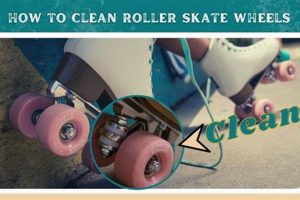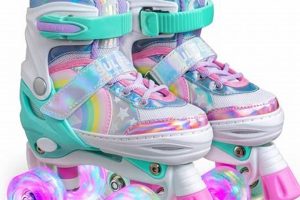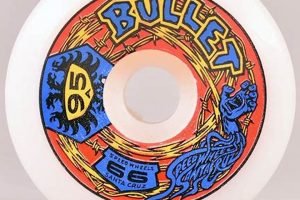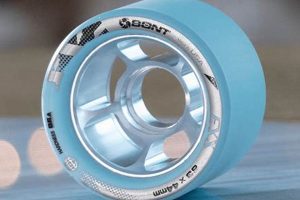The measurement of a roller skate wheel’s resistance to indentation is quantified using a durometer scale. This scale, most commonly the Shore A scale for skate wheels, assigns a numerical value to the material’s hardness. A lower number indicates a softer wheel with greater grip, while a higher number represents a harder wheel that prioritizes speed and slide. For instance, a wheel rated 78A would be considered soft and suitable for outdoor skating on rough surfaces, offering more absorption and control. In contrast, a wheel marked 101A or higher signifies extreme hardness, often preferred for smooth, indoor surfaces or specialized skating styles like aggressive skating where controlled sliding is essential.
Understanding the correlation between durometer and performance is paramount for optimizing the skating experience. Selecting appropriate wheel hardness can significantly impact factors such as speed, grip, wear resistance, and rider comfort. The development and implementation of standardized hardness measurements have facilitated informed purchasing decisions, allowing skaters to tailor their equipment to specific skating environments and personal preferences. This standardization has also enabled manufacturers to consistently produce wheels that meet the demands of a diverse skating population, contributing to the growth and evolution of the sport.
The subsequent discussion will delve into specific hardness ranges and their applications, explore the impact of wheel material on durometer readings, and examine how different skating disciplines benefit from particular wheel hardness characteristics. Furthermore, guidance on selecting the ideal durometer for various skating scenarios will be provided, enabling both novice and experienced skaters to enhance their performance and enjoyment.
Guidance on Roller Skate Wheel Durometer Selection
Selecting an appropriate wheel durometer enhances performance and enjoyment. Consider the factors outlined below for optimal wheel choice.
Tip 1: Assess Skating Surface. A rough outdoor surface necessitates softer wheels (78A-85A) for improved shock absorption and grip. Smooth indoor surfaces benefit from harder wheels (88A and above) that promote speed and roll.
Tip 2: Evaluate Skating Style. Recreational skaters often find mid-range durometers (82A-88A) versatile. Aggressive skaters typically require harder wheels (95A-101A+) for controlled sliding and durability on ramps and rails.
Tip 3: Consider Skater Weight. Heavier skaters may benefit from slightly harder wheels to prevent excessive compression and maintain speed. Lighter skaters might prefer softer wheels for enhanced grip.
Tip 4: Prioritize Comfort vs. Performance. Softer wheels offer greater comfort and shock absorption but may sacrifice speed. Harder wheels provide superior speed and roll but can transmit more vibrations.
Tip 5: Understand Wheel Profile. A wider wheel profile increases surface contact and grip, often paired with softer durometers. A narrower profile reduces friction and enhances speed, typically found in conjunction with harder durometers.
Tip 6: Experiment with Different Durometers. Trying various wheel hardness levels allows skaters to determine their preferred balance of speed, grip, and comfort based on personal preference and skating environment.
Tip 7: Regular Wheel Maintenance. Proper wheel maintenance, including cleaning and rotation, extends wheel life and preserves consistent performance regardless of durometer.
Selecting the correct wheel hardness is a crucial element in achieving optimal skating performance. By carefully evaluating the skating environment, style, and personal preferences, skaters can make informed decisions that enhance their overall experience.
The subsequent discussion will explore specific wheel materials and their influence on durometer readings, providing further insight into the complex relationship between wheel characteristics and skating performance.
1. Durometer Measurement Standard
The reliability and comparability of the roller skate wheel hardness scale are contingent upon adherence to a defined durometer measurement standard. Without a standardized procedure, durometer readings would be subjective and inconsistent, rendering the scale meaningless. The Shore durometer, particularly the Shore A scale, serves as the prevailing standard for measuring the hardness of roller skate wheels. This standard dictates the geometry of the indenter, the applied force, and the method for interpreting the resulting indentation. Consequently, it enables manufacturers to consistently produce wheels with predictable performance characteristics.
The practical significance of the durometer measurement standard is evident in several aspects of the roller skating industry. For example, a skater purchasing wheels labeled “85A” expects a certain level of grip and roll, regardless of the manufacturer. This expectation is upheld by the consistent application of the Shore A standard. Furthermore, research and development efforts aimed at optimizing wheel performance rely on accurate and repeatable hardness measurements. Without a standardized method, it would be impossible to reliably assess the impact of different materials or manufacturing processes on wheel hardness and performance.
The continued adherence to and refinement of durometer measurement standards remains crucial for maintaining the integrity and usefulness of the roller skate wheel hardness scale. Challenges arise from the introduction of new wheel materials and manufacturing techniques, which may necessitate adjustments to the existing standards. However, the fundamental principle of standardized measurement remains essential for ensuring that the scale accurately reflects the performance characteristics of roller skate wheels and facilitates informed decision-making by skaters and manufacturers alike.
2. Shore A Scale Specificity
The Shore A scale is a specific subset within the broader durometer measurement system, uniquely tailored for gauging the hardness of softer, more pliable materials. Its significance within the context of the roller skate wheel hardness scale stems from the prevalence of polyurethane as the primary construction material for these wheels. Polyurethane compounds typically exhibit hardness values that fall within the range effectively measured by the Shore A scale. Consequently, its adoption as the standard measurement tool provides a practical and relevant means of characterizing wheel hardness. The use of an inappropriate scale, such as the Shore D scale (designed for harder plastics), would yield less sensitive and less informative readings for typical roller skate wheel compositions.
The practical consequence of Shore A scale specificity is evident in the granularity of the hardness ratings assigned to wheels. A distinction between an 82A wheel and an 85A wheel, for instance, represents a perceptible difference in grip and roll performance due to the scale’s resolution within that range. This level of differentiation allows skaters to fine-tune their equipment choices based on specific surface conditions and skating styles. Furthermore, the consistency of the Shore A scale across different manufacturers ensures a degree of standardization, enabling skaters to compare wheels from various brands based on a common hardness metric. This promotes informed purchasing decisions and facilitates performance comparisons.
In summary, the selection of the Shore A scale for the roller skate wheel hardness scale is not arbitrary but reflects the material properties of typical skate wheels. Its specificity ensures relevant and informative hardness ratings, enabling performance optimization and standardization across the industry. While alternative measurement techniques may exist, the Shore A scale remains the most appropriate and practical tool for quantifying the hardness characteristics of polyurethane roller skate wheels, effectively serving skaters and manufacturers.
3. Lower Values
Within the framework of the roller skate wheel hardness scale, lower numerical values, typically ranging from 78A to 85A on the Shore A scale, directly correspond to softer wheel compounds. This relationship is causal; a lower durometer reading signifies a decreased resistance to indentation, indicating a more pliable and elastic material. The importance of understanding this connection is paramount, as wheel hardness significantly impacts grip, shock absorption, and rolling resistance. For instance, a skater utilizing a softer wheel on a rough outdoor surface experiences enhanced comfort and control due to the wheel’s ability to conform to imperfections and maintain contact. Conversely, employing such wheels on a smooth indoor surface results in reduced speed and increased rolling resistance, diminishing performance.
The practical significance of associating lower durometer values with softer wheels is evident in wheel selection for various skating disciplines. Recreational skaters, particularly those primarily skating outdoors, frequently benefit from softer wheels due to their superior ability to absorb vibrations and maintain grip on uneven terrain. Similarly, skaters engaging in distance skating on varying surfaces often opt for softer wheels to minimize fatigue and maintain consistent speed. In contrast, figure skaters or speed skaters, who prioritize precise movements and maximum velocity on smooth surfaces, typically choose harder wheels that offer minimal deformation and rolling resistance. This tailored approach to wheel selection underscores the direct relationship between durometer values and wheel performance.
In conclusion, the correlation between lower numerical values on the roller skate wheel hardness scale and the resulting softness of the wheel compound is fundamental to understanding wheel performance. The skater’s ability to effectively interpret durometer ratings enables informed decision-making, leading to optimized skating experiences tailored to specific environments and disciplines. While other factors, such as wheel material and profile, also influence performance, the durometer reading remains a crucial indicator of the wheel’s primary characteristics, directly impacting grip, comfort, and speed.
4. Higher Values
The upper end of the roller skate wheel hardness scale, characterized by higher numerical values, signifies a distinct category of wheel properties that cater to specific skating demands. These harder wheels exhibit characteristics that directly impact performance, making them suitable for particular environments and skating styles.
- Reduced Deformation
Harder wheels, typically rated 88A and above on the Shore A scale, undergo minimal deformation under load. This rigidity translates to greater energy transfer with each push, resulting in enhanced speed and efficiency. Examples include speed skating and roller derby, where minimizing energy loss is critical for maximizing performance. The implication is improved acceleration and sustained velocity, but at the potential expense of grip and comfort.
- Enhanced Roll
Due to their reduced deformation, harder wheels experience less rolling resistance on smooth surfaces. This characteristic results in prolonged roll and decreased effort to maintain momentum. Indoor skating rinks and polished concrete surfaces are ideal environments for harder wheels, allowing skaters to cover more distance with less exertion. The result is increased efficiency and reduced fatigue, particularly during extended skating sessions.
- Increased Durability
Harder wheel compounds generally exhibit greater abrasion resistance, extending their lifespan, especially on smooth surfaces. While softer wheels may wear down more quickly due to increased friction, harder wheels withstand prolonged use with minimal degradation. Aggressive skating, involving frequent contact with rough surfaces and obstacles, often necessitates harder wheels to resist chipping and wear. The increased longevity translates to reduced replacement frequency and lower long-term costs.
- Limited Shock Absorption
A notable tradeoff of harder wheels is their diminished capacity for shock absorption. The rigidity of the material transmits vibrations and impacts more directly to the skater’s feet and joints. Consequently, harder wheels are less suitable for rough or uneven surfaces where shock absorption is essential for comfort and control. Skaters using harder wheels on such surfaces may experience increased fatigue and discomfort. Proper technique and supportive footwear can mitigate these effects to some extent.
The selection of harder wheels within the roller skate wheel hardness scale necessitates careful consideration of the trade-offs between speed, durability, and comfort. While offering advantages in terms of efficiency and longevity on smooth surfaces, harder wheels may compromise shock absorption and grip, potentially limiting their suitability for all skating environments and styles. Skaters must weigh these factors to optimize their wheel choice based on their specific needs and preferences.
5. Grip Versus Speed Tradeoff
The intrinsic relationship between grip and speed represents a fundamental consideration in roller skate wheel selection, directly governed by the durometer, as indicated on the roller skate wheel hardness scale. This tradeoff dictates the performance characteristics attainable and necessitates a compromise based on intended use and skating conditions.
- Durometer as a Mediator
The durometer rating serves as the primary mediator in the grip versus speed dynamic. Lower durometer values, indicating softer wheels, inherently provide greater grip due to increased surface contact and deformation. This increased friction, however, reduces rolling efficiency and consequently, speed. Conversely, higher durometer values signify harder wheels that prioritize speed through minimized friction but sacrifice grip, particularly on uneven or slippery surfaces. Selecting the appropriate durometer involves a deliberate assessment of the relative importance of these opposing characteristics.
- Surface Condition Dependency
The optimality of grip versus speed balance is heavily contingent upon the skating surface. Smooth, indoor surfaces favor harder wheels, as grip is less critical, and speed becomes paramount. Conversely, rough outdoor surfaces necessitate softer wheels to maintain control and compensate for surface irregularities. Ignoring this dependency leads to suboptimal performance, ranging from reduced speed and efficiency on smooth surfaces to compromised safety and control on rough terrain.
- Skating Style Influence
Different skating disciplines inherently prioritize either grip or speed, thereby influencing wheel selection. Speed skating and roller derby, for example, emphasize speed and efficiency, leading to the preference for harder wheels. Conversely, recreational skating and jam skating often prioritize maneuverability and control, thus favoring softer wheels. The choice of wheel hardness, therefore, directly reflects the specific demands of the chosen skating style, impacting both performance and safety.
- Compound Material Modulation
While durometer is the primary determinant of grip versus speed, the specific polyurethane compound used in wheel construction can subtly modulate this tradeoff. Certain compounds may exhibit a greater degree of rebound, enhancing speed without drastically sacrificing grip. Conversely, other compounds may prioritize grip at the expense of speed. Understanding the nuances of different polyurethane formulations allows for further fine-tuning of the grip versus speed balance beyond the basic durometer rating.
In summary, the grip versus speed tradeoff represents a fundamental design constraint in roller skate wheel technology, directly reflected in the roller skate wheel hardness scale. The optimal balance between these competing attributes is contingent upon a complex interplay of factors, including durometer, surface condition, skating style, and wheel material. Skaters must carefully consider these factors to select wheels that maximize performance and safety for their specific needs and conditions.
6. Surface Adaptation Necessity
The roller skate wheel hardness scale provides a quantifiable measure directly impacting a wheel’s ability to conform to varying terrains. Surface adaptation necessity underscores the critical demand for wheel selection to align with the intended skating environment. The hardness of the wheel dictates its capacity to absorb vibrations and maintain contact with the skating surface. Harder wheels, registering higher on the scale, offer minimal deformation and are suitable for smooth, even surfaces like polished concrete or indoor rinks. In contrast, softer wheels, represented by lower values, provide greater compliance to uneven surfaces, such as asphalt or textured outdoor environments. This difference in surface adaptation has a direct influence on comfort, control, and energy expenditure during skating. For example, utilizing hard wheels on a rough surface results in increased vibration transmission and decreased grip, leading to rider discomfort and potential loss of control. Conversely, employing soft wheels on a smooth surface diminishes speed and efficiency due to increased rolling resistance. The correct application of the roller skate wheel hardness scale hinges on effectively assessing surface characteristics and selecting wheels that provide an optimal balance of grip and rolling efficiency.
The practical significance of surface adaptation necessity extends beyond mere comfort or convenience. Choosing the wrong wheel hardness can increase the risk of injury. Inadequate grip on a slippery surface, such as a wet or icy patch, can lead to falls and potential harm. Similarly, insufficient shock absorption on a rough surface can result in joint strain and fatigue over extended skating sessions. Understanding the relationship between surface conditions and wheel hardness allows skaters to mitigate these risks and enhance their overall skating experience. For instance, a skater transitioning from an indoor rink to an outdoor trail would benefit from switching to softer wheels to maintain stability and absorb surface irregularities. This adaptation not only improves safety but also prolongs the life of the skater’s joints and muscles by reducing impact stress.
In conclusion, the roller skate wheel hardness scale is not merely an abstract measurement but a practical tool directly linked to the skater’s ability to adapt to varying surface conditions. The success of any skating activity relies on the skater’s capacity to accurately assess the demands of the terrain and select wheels that provide the appropriate level of surface adaptation. By recognizing the importance of surface adaptation necessity and using the roller skate wheel hardness scale as a guide, skaters can optimize their performance, enhance their safety, and maximize their enjoyment of the sport.
7. Performance Impact Variability
The roller skate wheel hardness scale, while providing a standardized measure of wheel durometer, does not fully encapsulate the complexity of performance outcomes. Performance impact variability acknowledges that factors beyond a single hardness rating significantly influence the skating experience, necessitating a nuanced understanding of how these variables interact.
- Skating Style Dependence
The performance benefits of a particular wheel hardness are contingent upon the skater’s style and technique. An aggressive skater relying on sliding and controlled stops will experience the same wheel hardness differently than a speed skater prioritizing minimal rolling resistance. This disparity stems from differing weight distribution, movement patterns, and skill levels. A harder wheel may enhance speed for a skilled speed skater, while proving unwieldy and unstable for a novice attempting similar maneuvers.
- Surface Condition Sensitivity
The interaction between wheel hardness and surface condition introduces significant variability. A wheel optimized for smooth indoor surfaces may perform poorly on rough outdoor terrain, regardless of its durometer rating. The degree of surface roughness, presence of debris, and variations in surface material all contribute to performance discrepancies. A softer wheel may excel on asphalt due to improved grip and vibration absorption, while a harder wheel struggles to maintain contact and control.
- Wheel Material Influence
The specific polyurethane formulation used in wheel construction modulates the performance impact of a given durometer rating. Different compounds exhibit varying degrees of rebound, abrasion resistance, and grip independent of hardness. A wheel with a higher durometer rating but a grippier compound may offer similar traction to a softer wheel with a less adhesive formulation. This material influence necessitates considering factors beyond the durometer value when assessing overall performance potential.
- Skater Weight and Skill
A skater’s mass and skill level significantly influence the performance experienced with a given wheel hardness. A heavier skater will exert greater force on the wheels, potentially negating the benefits of a harder compound designed for speed. A less experienced skater may struggle to control harder wheels, regardless of their theoretical performance advantages. The roller skate wheel hardness scale provides a reference point, but the skater’s individual attributes ultimately determine the realized performance.
These variables highlight the limitations of relying solely on the roller skate wheel hardness scale as a predictor of skating performance. While durometer provides a valuable metric, skaters must consider the interplay of skating style, surface conditions, wheel material, and personal attributes to optimize their equipment choices and achieve desired outcomes.
Frequently Asked Questions
This section addresses common inquiries regarding the roller skate wheel hardness scale, providing factual and objective information.
Question 1: What is the significance of the “A” designation following a numerical value on the roller skate wheel hardness scale?
The “A” denotes the Shore A scale, the standardized measurement system for determining the hardness of roller skate wheels, particularly those composed of polyurethane. This scale is appropriate for materials of intermediate hardness. Use of the Shore A designation indicates that the cited value adheres to this established standard.
Question 2: Does a higher numerical value on the roller skate wheel hardness scale universally equate to superior performance?
No. A higher value indicates a harder wheel, which may offer increased speed and roll on smooth surfaces. However, harder wheels typically provide less grip and shock absorption, potentially diminishing performance on rough or uneven terrain. The optimal hardness is contingent upon the skating environment and the skater’s priorities.
Question 3: Can the roller skate wheel hardness scale predict wheel lifespan?
The hardness scale provides a limited indication of wheel durability. Harder wheels tend to exhibit greater resistance to abrasion on smooth surfaces, potentially extending their lifespan. However, factors such as wheel material composition, skating style, and surface conditions also significantly influence wear rate.
Question 4: Is there a universally recommended wheel hardness for all roller skaters?
No. The ideal wheel hardness is highly subjective and depends on individual skating preferences, skill level, and the type of skating being performed. General recommendations can be made based on common scenarios, but personal experimentation is often necessary to determine the optimal choice.
Question 5: How does wheel material affect the interpretation of the roller skate wheel hardness scale?
The roller skate wheel hardness scale is primarily designed for polyurethane wheels. Variations in polyurethane formulations can subtly alter the relationship between durometer and performance. A wheel with a specialized polyurethane blend may exhibit characteristics that deviate slightly from the expected behavior based solely on its hardness rating.
Question 6: Is it possible to modify the hardness of a roller skate wheel after purchase?
No. The hardness of a roller skate wheel is inherent to its material composition and manufacturing process. It is not possible to alter the durometer after the wheel has been produced. Selecting the appropriate hardness at the time of purchase is therefore essential.
In summary, the roller skate wheel hardness scale is a valuable tool for understanding wheel characteristics. However, its interpretation should be contextualized with consideration for skating environment, style, material composition, and individual preferences.
The subsequent section will provide resources for further exploration of roller skate wheel technology and selection.
Conclusion
This examination has clarified the function and significance of the roller skate wheel hardness scale within the realm of skating equipment. The measurement, primarily utilizing the Shore A scale, provides a standardized metric for understanding the performance attributes of skate wheels. Factors influencing durometer selection, including skating surface, style, and individual preferences, have been thoroughly explored, emphasizing the necessity of informed decision-making when choosing equipment. Limitations of the scale, such as its inability to fully account for material variations and individual skater attributes, have also been acknowledged.
Therefore, the roller skate wheel hardness scale should be viewed as a valuable tool within a broader context of equipment selection. Further research and development in wheel materials and measurement techniques may refine the scale’s precision and predictive capabilities. Skaters are encouraged to utilize the information presented herein to make informed decisions, optimizing their skating experience and enhancing performance.







